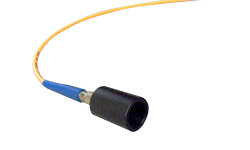The fiber-coupled high power UV, Violet, Blue, Green, Yellow, Red and NIR LED multi wavelength light source modules are
effective replacements of lasers and lamps in many applications, such as spectroscopy, bio-illumination and point curing.
Currently available models are FC2-LED, FC3-LED, FC5-LED, FC10-LED (only with USB control).
Single channel module is also available (see
Silver-LED ).
Each LED has separate current driver with discrete controls. The driver supports CW and pulsed operation mode.
For each LED channel manual power control is provided by 10 turns potentiometer with counting dial. For computer control optional USB port is provided.
Prizmatix LED-CTRL software is avalible as Application running on Google Chrome browser for Mac or Windows. For Windows users desktop application is available.
For advanced users software API is available.
The external TTL inputs enable external triggering of each LED separately.
Both Analog Inputs and TTL inputs are optically isolated with fast opto-couplers.
The fiber coupled LED sources are ideal for use with various fiber optic spectrometers in continuous, strobe or external triggering measurement mode. Currently the multi-wavelength fiber coupled light source modules can include any combination of wavelengths from the table below.
Features
- High output power (see table below)
- SMA fiber connection
- Precisely adjustable power by 10 turns potentiometer
- TTL external modulation input (up to 50KHz)
- Analogue input (0-5V) for power control
- TTL and Analogue input are optically isolated
- Low optical noise <0.05% RMS
- Long life (no lamp replacement required)
Electro-Optical Specifications
|
|||||||||||||||||||||||||||
|
|
|||||||||||||||||||||||||||
General Specifications:
|
|||||||||||||||||||||||||||
|
Optional Accessories
|
|||||||||||||||||||||||||||


